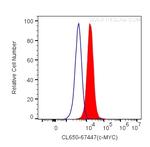Search Thermo Fisher Scientific
FIGURE: 1 / 1
c-MYC Antibody (CL647-67447) in Flow

Product Details
CL647-67447
Species Reactivity
Host/Isotype
Class
Type
Clone
Immunogen
Conjugate
Excitation/Emission Max
Form
Purification
Storage buffer
Contains
Storage conditions
Shipping conditions
Product Specific Information
Immunogen sequence: MPLNVSFTNR NYDLDYDSVQ PYFYCDEEEN FYQQQQQSEL QPPAPSEDIW KKFELLPTPP LSPSRRSGLC SPSYVAVTPF SLRGDNDGGG GSFSTADQLE MVTELLGGDM VNQSFICDPD DETFIKNIII QDCMWSGFSA AAKLVSEKLA SYQAARKDSG SPNPARGHSV CSTSSLYLQD LSAAASECID PSVVFPYPLN DSSSPKSCAS QDSSAFSPSS DSLLSSTESS PQGSPEPLVL HEETPPTTSS DSEEEQEDEE EIDVVSVEKR QAPGKRSESG SPSAGGHSKP PHSPLVLKRC HVSTHQHNYA APPSTRKDYP AAKRVKLDSV RVLRQISNNR KCTSPRSSDT EENVKRRTHN VLERQRRNEL KRSFFALRDQ IPELENNEKA PKVVILKKAT AYILSVQAEE QKLISEEDLL RKRREQLKHK LEQLRNSCA
Target Information
The c-Myc protein is a 62 kDa transcription factor that is encoded by the c-Myc gene on human chromosome 8q24. c-Myc is commonly activated in a variety of tumor cells and plays an important role in cellular proliferation, differentiation, apoptosis and cell cycle progression. The phosphorylation of c-Myc has been investigated and previous studies have suggested a functional association between phosphorylation at Thr58/Ser62 by glycogen synthase kinase 3, cyclin dependent kinase, ERK2 and C-Jun N terminal Kinase (JNK) in cell proliferation and cell cycle regulation. Studies have shown that c-Myc is essential for vasculogenesis and angiogenesis in tumor development, which distributes blood throughout the cells. The c-myc oncogene (p62 c-myc) is involved in the control of normal cellular proliferation and differentiation, and the deregulated expression of c-Myc induces apoptosis in different cell types. Antibodies against c-myc epitopes recognize overexpressed proteins containing Myc epitope tag fused to either amino- or carboxy-termini of targeted proteins. c-Myc-, N-Myc- and L-Myc-encoded proteins function in cell proliferation, differentiation and neoplastic disease. Amplification of the c-Myc gene has been found in several types of human tumors including lung, breast and colon carcinomas, while the N-Myc gene has been found amplified in neuroblastomas. Translocation of the c-myc locus on chromosome 8 to the immunoglobulin loci on chromosome 14 (heavy chain); 2 (delta light chain); or 22 (light chain) is described in Burkitts lymphoma and other B-cell lymphoproliferative conditions. An aberrant expression of the c-myc gene occurs in tumors of different origins such as colorectal, gastric, gallbladder, hepatic, mammary, ovarian, endometrial, head and neck, pulmonary, prostatic, thyroidal, oral, ocular, nasopharyngeal, endocrine, as well as hematopoietic neoplasms.
For Research Use Only. Not for use in diagnostic procedures. Not for resale without express authorization.
References (0)
Bioinformatics
Protein Aliases: Avian myelocytomatosis viral (v-myc) oncogene homolog; avian myelocytomatosis viral oncogene homolog; bHLHe39; c Myc; c-myc epitope tag; c-myc proto-oncogene; Class E basic helix-loop-helix protein 39; cmyc; Myc proto-oncogene protein; myc-related translation/localization regulatory factor; myelocytomatosis viral oncogene homolog; Proto-oncogene c-Myc; Transcription factor p64; v-myc avian myelocytomatosis viral oncogene homolog; v-myc myelocytomatosis viral oncogene homolog
Gene Aliases: AU016757; BHLHE39; c-Myc; mMyc; MRTL; MYC; Myc2; MYCC; Niard; Nird; RNCMYC
UniProt ID: (Human) P01106, (Rat) P09416, (Mouse) P01108
Entrez Gene ID: (Human) 4609, (Rat) 24577, (Mouse) 17869

Performance Guarantee
If an Invitrogen™ antibody doesn't perform as described on our website or datasheet,we'll replace the product at no cost to you, or provide you with a credit for a future purchase.*
Learn more
We're here to help
Get expert recommendations for common problems or connect directly with an on staff expert for technical assistance related to applications, equipment and general product use.
Contact tech support
